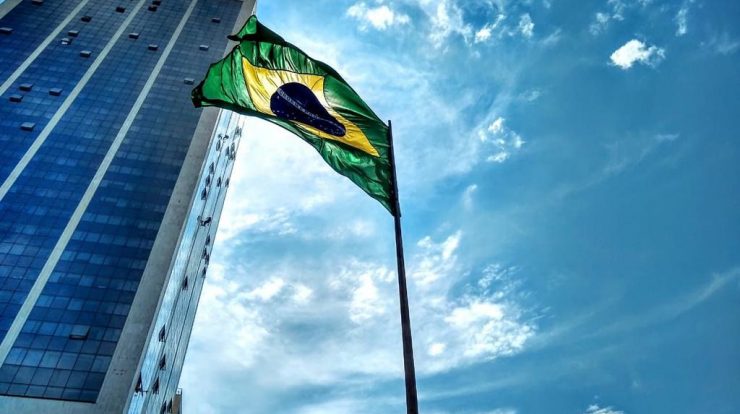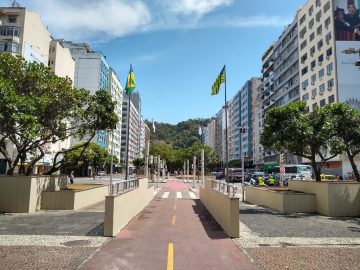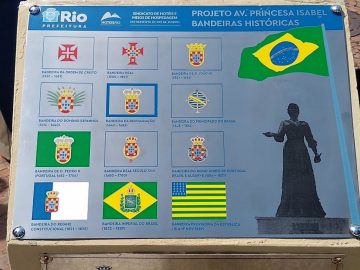
 Flag of Brazil on Avenida Princesa Isabel – Rodrigo Andrade / Rio City Hall
Flag of Brazil on Avenida Princesa Isabel – Rodrigo Andrade / Rio City Hall The Municipal Protection Department, in partnership with the Consortium of Hotels and Accommodations in the City of Rio (HotelsRio), has returned to the city the country’s historic flags, traditionally located on Avenida Princesa Isabel, in Copacabana. The handover ceremony took place on Friday morning (15/10).
Prior to the current flag, Brazil had 12 other flags, of which only three were created after Brazil’s independence – the previous flags were Portuguese, used in the country from the time of Pedro Alvares Cabral until 1822. Now, anyone who passes by Avenida Princesa Isabel will be able to On seeing each fluttering on the masts and knowing the details of each of them, read the memorial plaque installed in the place.
For Conservation Minister Anna-Laura Secco, the attention to detail that makes up the landscape of Rio is also a way to preserve history:
Preserving the monuments and raising our flags at important points in the city has always been a commitment by Mayor Eduardo Paes, who is passionate about the banks of Rio, but also for the beauty and culture of the wonderful city.
In addition to raising the flags, the restoration team also provided services in the surrounding areas, such as repairing the Portuguese stone floor on Avenida Princesa Isabel and its mast and Comlurb who did the cleaning and painting.

Discover the flags of Brazil:
1- Portuguese America (1500 to 1816)
The time when the Brazilian territory was only part of Portuguese America and did not have a flag of its own. Thus, according to tradition, Portugal raised the flag of the kingdom in all the lands belonging to its crown.
2- The Order of Christ (1319 to 1651)
It was an association (entity) that sponsored the great Portuguese navigators, and its flag reached Brazil with the caravans of Pedro Alvares Cabral, stamped on their sails. This was the national symbol of the Portuguese and was the first flag that was raised on Brazilian soil.
3- Royal Flag (1500 to 1521)
Used on ships that have reached Brazilian territory. Although formal, it gave space to Christ’s command on expeditions at sea. The royal flag was created by João II (1455-1495) of Portugal, and contained the white royal standard along with the state emblem.
4 – Flag of Dome Go 3 (1521 to 1616)
Used during the reign of Dom Joao III, King of Portugal. It was marked by important moments in Brazilian history, such as the colonial campaigns of 1530, hereditary captains in 1534, the establishment of general governments in 1549, and the division of Brazilian territory into two governments.
5- The Spanish Domain (1616 to 1640)
Created by the King of Spain and Portugal Philip II, known in Spain as Philip III. The new flag retained the shield and crown of the Portuguese flag, but was surrounded by five branches on each side. It should be noted that during the period when this flag was used in Brazil, there were Dutch invasions in the northeast and the beginning of a pioneering expansion.
6- The Science of Restoration (1640 to 1656)
It was created after the Spanish evacuation. It marked the re-emergence of the Portuguese kingdom. Dom João IV was the king who put up this new flag, keeping the coat of arms of Portugal and adding a blue border, which is a veneration of the country’s patron saint, Nossa Senhora da Conceição.
7- Flag of the Principality of Brazil (1645 to 1816)
It was the first flag created exclusively for Brazil, when Dom João IV conferred the title of Prince of Brazil to his son Theodosio, making the territory considered a principality. Although it was the first exclusive flag, it was not the first national flag, as Brazil has not yet been considered an independent country.
8 – Dom Pedro II Flagg (1683 to 1706)
Differently from the others, the Dom Pedro II flag was used at the height of the Banderants’ voyages, between 1683 and 1706. For the first time, the green rectangle was included, which is still used in the Brazilian flag.
9- The royal flag of the seventeenth century (1600-1700)
It was created by Dom Pedro II and used as the official symbol of the kingdom, along with the flag of the Restoration, the Principality of Brazil and the flag of Dom Pedro II. On this flag a chain and a red cross were added to the order of Christ.
10. Flag of the Kingdom of Brazil (1815 – 1822)
It was created with the arrival of the royal family to Brazil in 1808, and marked by a series of changes in the kingdom. One of them was the elevation of the principality’s title to the United Kingdom in 1815, causing the current flag to change again.
11- Flag of the United Kingdom of Portugal, Brazil and the Algarve (1816 to 1821)
In 1815 the United Kingdom of Portugal, Brazil and the Algarve was created, but the flag of the kingdom was only in May 1816. Brazil is represented in the new flag by the blue ball. This flag was carried over to the struggles against the incorporation of Cisplatina and the Pernambuco Revolution of 1817.
12- The science of constitutional order (1821 to 1822)
This was the last Portuguese flag to fly in Brazil as a colony, created a year after the abolition of the absolute monarchy in Portugal, to establish the constitutional order. The current flag was between 1821 and 1822 and was present during the Grito do Ipiranga, on September 7, 1822, which began the political emancipation of Brazil.
13 – Flag of the Republic (1889 to date)

